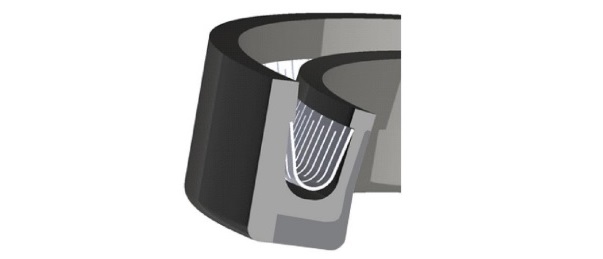What are the benefits of seals made from two different materials?
Introduction
The rotary shaft seals offered by Kalsi Engineering come in various styles for specific operating conditions. All the styles have one thing in common: hydrodynamic waves that face a lubricant and pump a film of the lubricant into the dynamic sealing interface during rotation. The lubricant film serves to reduce friction and seal-generated heat. What this means is less wear, and better retention of material properties.
Many of the rotary shaft seals we offer are constructed from two different materials and are designed to retain high pressure. Of these, some are high pressure lip seals that engage the shaft with a flexing lip. Others are direct compression seals that have a dynamic lip that projects radially inward from a solid seal body and is held in contact with the shaft by the radial compression of the seal body.
Direct compression seals with composite construction
The direct compression seals that we offer with composite construction are typically used as high-pressure oil seals. Their purpose is to prevent the high-pressure lubricant from escaping through the annular clearance between a housing and a relatively rotatable shaft. In the seal industry, this clearance is known as an “extrusion gap”. With seals constructed from polymeric materials, pressure can extrude seal material into the clearance. This extruded material eventually breaks away from the seal due to factors such as stress resulting from dynamic runout of the shaft, pressure cycles, etc. This extrusion-related damage can cause seal failure, as more and more of the seal is nibbled away.
In general, the higher the modulus of the seal material, the more resistant the material is to extrusion damage. There is, however, a practical limit
to the modulus that can be used in a direct compression rotary seal made from a single material, because higher modulus materials increase
interfacial contact pressure. Kalsi Seals made from two materials avoid this problem by making most of the seal from a lower modulus elastomer and lining the dynamic lip with a relatively thin layer of the higher modulus, more extrusion resistant material. This construction positions the higher modulus material at the extrusion gap where it is needed. The interfacial contact pressure is kept reasonably low, because the higher modulus layer is initially loaded against the shaft by compression of the lower modulus material that most of the seal is constructed from.
With our direct compression seals, the higher modulus inner layer can be constructed from either elastomer or plastic. The use of a higher modulus
elastomer layer can be used with most of our direct compression rotary shaft seal product line, except for axially constrained seals. Elastomer seals with such dual material construction are referred to as “Dual Durometer Seals™”. The highest-pressure capacity can be obtained with Plastic Lined Seals™, but the use of the plastic liner is limited to seals that incorporate our Enhanced Lubrication™-type hydrodynamic waves.
In addition to increasing the extrusion resistance of the rotary seal, the use of a higher modulus liner also provides a significant reduction in breakout torque. With Dual Durometer Seals this advantage is primarily limited to low pressure conditions. Plastic lined seals also have reduced breakout torque in high pressure conditions, compared to seals constructed entirely from elastomer, due to the low friction characteristics of the plastic liner.

High pressure lip seals with composite construction
Our high-pressure lip seals, known as KLS® seals, use a plastic liner for the same reason as our direct compression rotary shaft seals: Increased extrusion resistance. The hydrodynamic waves of our high-pressure lip seals are located on the low-pressure end of the seal, so the use of a plastic liner is also needed to prevent the collapse of the waves when high differential pressure is present. KLS seals were originally developed for the demanding operating conditions encountered in oilfield rotating control devices (RCDs).

Where to get additional information on high-pressure shaft seals
For additional information about our high pressure shaft seals, including how to incorporate them in your equipment, see our shaft seal handbook and contact us with any questions you may have. Requests for quotations can be forwarded to us via e-mail, or by fax at 281-240-0255.
Who is Kalsi Engineering?
Kalsi Engineering, a leading high pressure oil seal supplier, was founded in 1978 by M. S. Kalsi, Ph. D. The company was established to provide mechanical engineering services for equipment and structures in the areas of design, analysis, testing, and R&D. Part of the company still provides such services.
Our high pressure rotary seal product line has its genesis in the groundbreaking elasto-hydrodynamic lubrication research that was conducted by Dr. Kalsi while earning his masters and doctorate degrees. After founding Kalsi Engineering, part of the company was dedicated to research and development in the field of high-pressure oil seals. Our first commercially successful rotary shaft seals became a reality in the 1980s and were used as oilfield seals. Since then, our ongoing commitment to research and development has resulted in continual product improvement, and what we believe to be the most pressure-capable polymeric high-pressure oil seals on the planet.